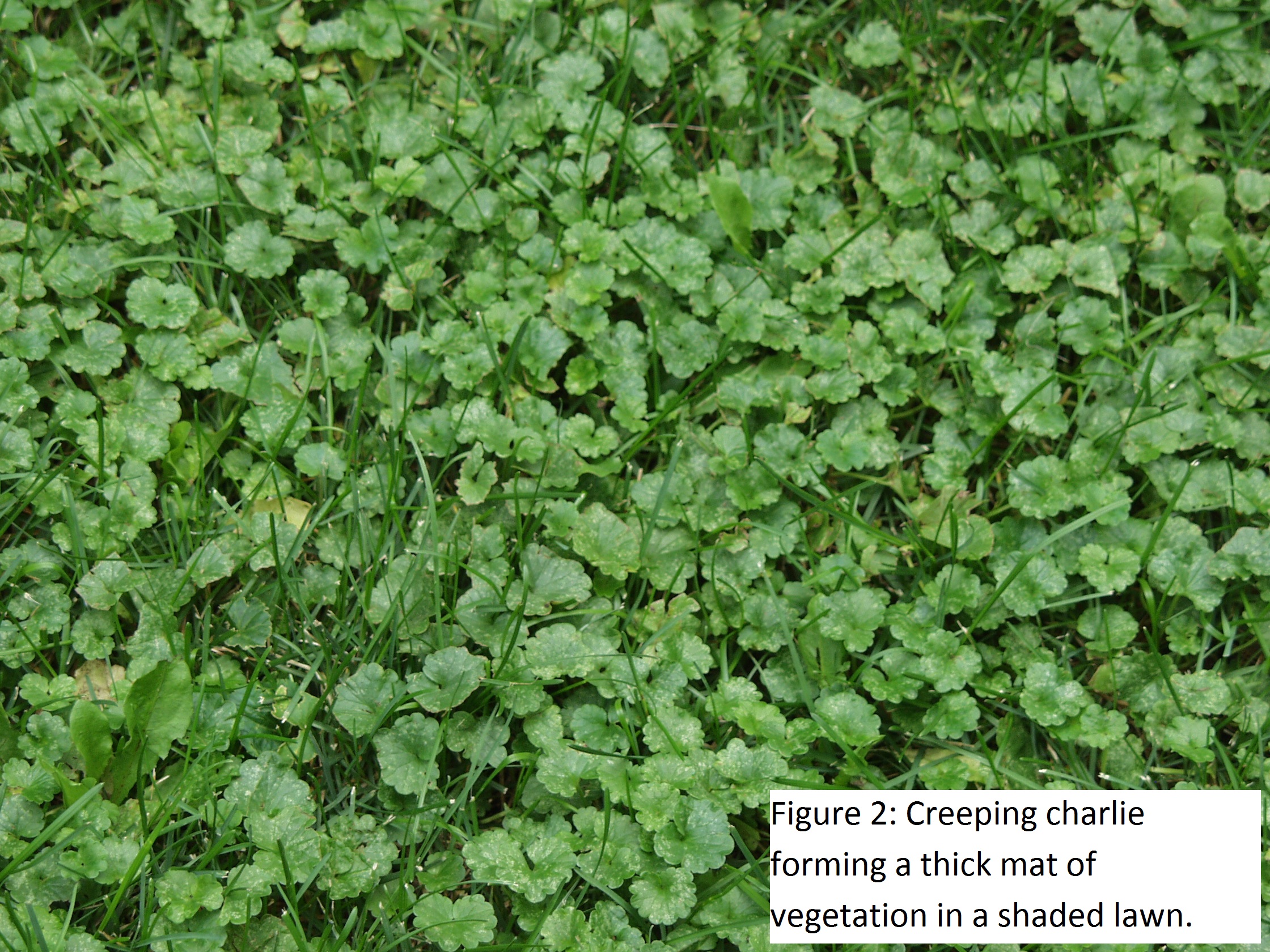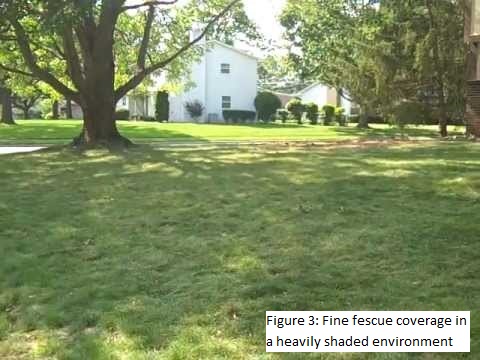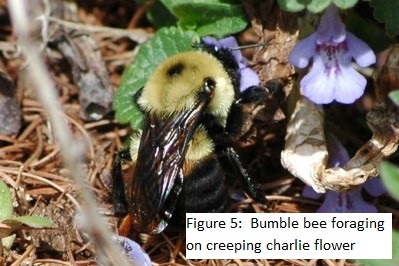By James Wolfin and Phoebe Koenig - UMN Bee Lab
Natural history, identification, and growth habit
Creeping Charlie (Glechoma hederacea L.), also called ground ivy, is a common herbaceous perennial native to the British Isles. Creeping Charlie has since spread to North America, and has been present in our landscapes for nearly 200 years. While some consider creeping Charlie to be a weedy species, others consider it to be naturalized, and some seed providers will sell this flower as a form of ornamental ground cover. Creeping Charlie is an early spring bloomer (April-May) that is easily recognized by its small, pale violet flower. It grows well in shaded areas with fine-textured soils that are damp and slightly acidic to slightly alkaline (pH 5-7.5). Creeping Charlie spreads rapidly through stoloniferous growth, where stems grow at the soil surface and spread laterally. These stems are commonly referred to as “runners” and allow creeping Charlie to grow in its easily identifiable mat-like form of ground cover (Hutchings and Price 1999).
Creeping Charlie and lawns
Creeping Charlie is considered by many to be a nuisance weed in lawns. Creeping Charlie will infiltrate lawn areas that have been neglected or otherwise poorly managed. Once established within a lawn, creeping Charlie may suppress the growth of surrounding plants, due to a characteristic called “allelopathy”. An allelopathic plant will produce biochemicals that deter the fitness of surrounding plants. One study (Rice, 1986) found that flowers growing alongside creeping Charlie experienced decreased seed germination and faster rates of root and shoot growth.
An effective way to exclude creeping Charlie from your home lawn is by enacting responsible lawn management practices. The first thing to consider when establishing a home lawn should be species selection. In shaded areas, where creeping Charlie often thrives, it is important to utilize grasses like the fine fescues (Festuca spp), which are known to perform well in these areas. In the northern climates of the United States, Kentucky blu.egrass is the most common species of turfgrass. While Kentucky bluegrass is a high quality turfgrass that performs well in terms of winter hardiness, this species of grass struggles in shady areas. Both tall fescue (Festuca arundinacea) and fine fescue (Festuca spp.) are cool-climate turfgrass species that do well in shady areas. Mixing fescues with Kentucky bluegrass is an effective way to ensure that strong turfgrass density is present despite the shade provided by common yard trees. In addition to employing careful turfgrass species selection, it is important to utilize well informed mowing, irrigation, and fertilizer regimes to ensure proper turgrass health and density.
When creeping Charlie is present, but in low numbers, it may be possible to control the weed via hand weeding. When hand weeding, it is critical to remove the roots as well as the above ground portion of the plant to ensure that there is no re-emergence. Due to the aggressiveness of creeping Charlie, multiple weeding events may be required to remove all creeping Charlie vegetation. Management practices may also be imparted to favor the growth of turfgrass instead of creeping Charlie. A study by Price and Hutchings (1986) noted that creeping Charlie is less abundant when turfgrass is present, as the grass provides competition for sunlight and soil nutrients. Increasing access to sunlight will improve turfgrass growth, limiting the ability of creeping Charlie to spread through the turf lawn.
If creeping Charlie has already overtaken a lawn, there are several options for eradication. A sod-cutter is a machine that typically removes sod for transplant into a new lawn, but can also be used to quickly remove strips of weeds, like creeping Charlie, from a lawn. Removing strips of creeping Charlie will create an area of bare soil within the lawn, so if a sod-cutter is the preferred method of removal for a homeowner, it is important that all creeping Charlie vegetation is eradicated to prevent re-invasion. If any piece of plant material is not removed, there is potential for creeping Charlie to re-establish within the lawn. After all creeping Charlie vegetation is removed, the areas of bare soil should be seeded with high quality turfgrass to ensure dense, uniform germination throughout the area. Lawns with dense turfgrass coverage are less susceptible to weed invasion, including invasion by creeping Charlie. A second way to remove an area of a lawn overrun by creeping Charlie is through solarization.
Solarization is a pesticide free form of weed control that involves placing a clear plastic sheet over the soil during the warm months of spring and summer. The clear plastic sheet captures heat and sunlight, raising soil temperatures to the point where grasses and weeds can no longer survive. Solarization is best fit for sunny, flat sites that are less than 1/4 of an acre in size. In cooler, shaded areas (where creeping Charlie is likely to be found) the process of solarization takes the better part of a growing season, typically 5-6 months, or up to a full year in some instances. Additional information on solarization can be found through the Xerces society. The plastic should be removed in the late fall when soil temperatures are 35-55°F so that new grass can be installed via dormant seeding. Dormant seeding occurs at these temperatures because the soil is too cold for germination to occur, but the ground is not yet frozen. This ensures that the target species seeded into the newly prepared area will germinate once the proper number of degree days has occurred. If seeded properly, the new turfgrass area should be dense, uniform, and free of weed pressure. An additional strategy that can be used to remove a creeping Charlie infestation is the use of chemical herbicides, specifically herbicides where glyphosate or triclopyr are active ingredient. While this is a less ecologically friendly solution to removing an undesirable weedy species, it is an effective way to remove this invasive weed. Applications of glyphosate are most effective on warm, calm days when plants are actively growing. It is important to avoid windy days to ensure that herbicide applications do not drift onto non-target plants. Glyphosate treatments are most effective when two treatments are applied, with the second treatment taking place 7-10 days after the initial treatment. After the creeping Charlie has been removed, high quality grass seed should be overseeded onto the turf lawn.
Value to bees and other pollinators
For those that live in an area where letting creeping Charlie grow is not a problem for neighbors, creeping Charlie can serve as a nectar source. Creeping Charlie employs a unique strategy to attract some bee visitors, such as sweat bees, bumble bees, and honey bees, that is tied into how the flower produces nectar. The flowers have a unique strategy for rewarding visitor pollinators, commonly referred to as the “lucky hit” strategy. Creeping Charlie flowers produce an average of 0.3 microliters of nectar per flower, but the amount of nectar in any one flower varies greatly, ranging from 0.06 to 2.4 microliters. When 805 creeping Charlie flowers were sampled for nectar quantity, it was found that only 8% (64/805) of these flowers had a large volume of nectar, and the rest had almost none (Southwick et al. 1981). The availability of nectar also varies throughout the day. As the morning fades into afternoon, “lucky hits” become less frequent, as creeping Charlie flowers do not replenish their nectar throughout the day. Most flowers produce their nectar at night or in the early morning, so it is believed that all the “lucky hits” available in the afternoon are ones that were missed by bees earlier in the day. One researcher (Southwick et al. 1981) found that bees foraging on creeping Charlie for 5.9 minutes obtained enough nectar from the flowers to make foraging on creeping Charlie energetically profitable.
While Creeping Charlie could be a good nectar source for bees, we are not recommending that you let it take over your lawn. In addition to the issues associated with nectar production, pollen (the main protein source for bees) from creeping Charlie is not readily available to visiting bees and other insect pollinators. Bees need a variety of food sources, and the best lawns have many kinds of flowers, hopefully with a range of bloom times. Creeping Charlie is invasive, and can prevent you from growing additional flowers in your lawn. Instead, if you are looking to promote pollinator health in your lawn or garden, we recommend planting a diversity of flowers that produce high quality nectar and pollen consistently. That being said, if your lawn/garden is already overrun with creeping Charlie, and you have not had a chance to eradicate it yet, take pleasure in seeing the bees buzzing around it, and look out for when they spend extra time on one bloom. They are likely hitting the jackpot!
Bibliography
Dickinson, R. and Royer, F. Weeds of North America, University of Chicago Press, Chicago, IL. 2014
Ford, K. 2016. The value of lawn weeds for pollinators: not all weeds are created equal. University of Minnesota Extension Publication.
Hultén, E. 1971. The Circumpolar Plants. II. Dicotyledons. Almquist & Wiksell, Sweden.
Hutchings, M.J., Price, E.A.C. 1999. Glechoma hederacea L. (Nepeta glechoma Benth., N. hederacea (L.) Trev.)
Rice, E.L. 1986. Allelopathic growth stimulation. The Science of Allelopathy (eds A.R. Putnam & C.S. Tang), pp. 34-40. Wiley, Chichester, UK.
Southwick, E. E. "Lucky Hit" nectar rewards and energetics of plant and pollinators." Comparative Physiology and Ecology 7.2 (1982): 51-55.
Southwick, Edward E., Gerald M. Loper, and Steven E. Sadwick. "Nectar production, composition, energetics and pollinator attractiveness in spring flowers of western New York." American Journal of Botany (1981): 994-1002.



